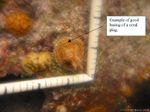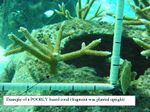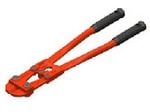This article describes the terminology used in coral reef rehabilitation projects
Terminology list[edit | edit source]
Acropora: A genus of fast growing hard corals that require the highest level of quality standards to be successfully planted. Includes threatened Elkhorn and Staghorn coral in the Caribbean. The Pacific contains a wide variety of Acropora species including the spectacular tabletop corals. They are one of the most desirable corals for propagation and planting due to rapid growth characteristics and classic "reef look" but usually are one of the most sensitive to poor water quality. There are notable exceptions such as Acropora arabensis, in the Arabian Gulf , that can handle variable sedimentation and turbidity and a wide range of temperatures.
Adva Flow: Brand name of a high range water reducer and plasticizer. Manufactured by W. R. Grace and Company [1] and added to cement to make it more liquid without adding water because too much water makes concrete weak. This admixture is required in the plug cement so that the concrete forms a perfect seal around the coral fragment to prevent bottom to top infections and dislodging of the fragment. It is also used in artificial reef module construction to help improve the pH and other concrete characteristics.
Antibacterial Soap: RBF Coral Team participants must wash their hands between each unique coral colony they touch with an antibacterial soap. However, not all sites have fresh water facilities to get a clean rinse so team members often use surgery rated products that offer a clean rinse. An example is LAGASSE, INC.'s "Antibacterial Lotion Soap" which contains 0.3% Chloroxylenol (PCMX), a broad-spectrum degerming agent and offers gentle cleansing with a clean rinse. Alcohol-based or waterless hand cleaners can also be used, but they don't work well to remove some coral slimes, particularly oily type slimes. Generally they can be used between handling different colonies of the same species but it is best to use a soap based product when changing species types.
Antiseptic Dip (aka RBF Coral Antiseptic Dip): To reduce rapid tissue necrosis and other bacterial infections that can occur due to the fragging wound, hard coral specimens or fragments are dipped in an iodine based antiseptic solution immediately before being placed into coral plugs. RBF uses veterinary strength iodine commonly referred to as "Lugol's solution" and we repack this into user quantities and provide it to clients as "RBF Antiseptic Dip"in our coral kits. It is possible to use over the counter strengths but the amount of iodine needed may change the salinity of the dip, which must then be adjusted with artificial sea salt (available at any marine aquarium store) to match ambient seawater. Doing so will require a hydrometer or refractometer. Do not use fresh water to mix RBF Antiseptic Dip or any other iodine solution for coral. RBF Antiseptic Dip must be diluted using fresh seawater (or if possible, freshly made artificial sea water adjusted to the exact salinity of the sea where you are working, which has a longer working life). The standard dilution rate is 25ml iodine per liter of water (1 teaspoon per 8 ounces), although the solution can be made slightly weaker for slow growing corals such as brain or star corals, and slightly stronger for fast growing corals such as branching or finger corals. Additionally the dip solution must be kept at the same temperature as the sea, and it may need to be buffered to the same pH as the natural seawater, especially if maintained longer than an hour or two. For this reason, if resources permit, it is best to discard and replace the antiseptic dip frequently. If the fragment has been handled properly and the only injury is the fragmentation cut, then only that part of the coral fragment needs to be exposed to the dip, however if other injury is suspected, dip the whole fragment. Dipping time should be about 1 second to allow the iodine to penetrate into the coral skeleton. Proper treatment will stain the white skeleton to a slightly yellow color. If a yellow color does not show up after dipping, it is possible the coral have been over handled and the protective slime coating from handling has migrated over the exposed skeleton. If this is observed, advise all coral handlers to reduce the coral stress levels before proceeding. Ideally, coral should be exposed to air only one time during the entire process (when they are set into the rapid setting coral plug cement). Often, over-slimed coral can be traced to careless fragmenting, a procedure that must be carried out delicately to reduce coral stress. Note 1: Fire coral (Millepora spp.) and soft coral species should not be dipped in iodine solutions. To test compatibility with iodine solutions, create one set of test plugs dipped and a second set without dipping and monitor the results. Ill effects from iodine usually appear within 72 hours. Many coral propagation tables have been run successfully without antiseptic dips. If your procedures are very consistent and rapid tissue necrosis (RTN) is not showing up in your plugs, it is perfectly acceptable to skip this treatment. (Except for Acropora spp. where a dip should always be performed). Note 2: There are a variety of commercial antiseptic dips available to the marine aquarium trade. Presumably these are safe, and possibly effective but some of these products that are so diluted as to require long dipping times which are not practical for coral propagation table activities, and will overly stress fragmented coral. If used, follow the instructions from the manufacturer exactly. Do not use iodine solutions that also contain soap or detergents. Note 3: The Coral Team has experimented with some antibiotics (amoxcillin, ceprofloxin and erythromycin), and in our tests they seemed to cause more harm than good. While this technique may in the future, be refined to the point where it is safe and effective, at this point we don't recommend antibiotic treatments for coral. Note 4: There is recent science on microbial-coral interactions and new insights may help researchers to understand why the iodine solution is beneficial during coral fragmentation see "Microbial landscape on the outer tissue surfaces of the reef-building coral", Johnston and Rohwer 2007"
Aquascaping: The act of adding various members of the fouling community to a new base substrate with the objective of making it look more natural. Aquascaping can include coral, algae, sponges, attachment of live rock, anemones, etc. At the most sophisticated levels, it may include addition of particular species to benefit the development of the coral reef community such as adding sea urchins (Diadema antillarum or Echinoidea spp.). The term aquascaping was originally used in reference to aquarists arranging rocks and corals in marine reef aquariums and is applied here to base substrate enhancement. Many Coral Teams will send in specific aquascaping teams after all coral have been planted to provide the finishing touch to the rehabilitation process when aesthetics are an important project goal.

Base or Basing: Certain coral species (referred to as "basing coral") have a special 'survival mode' when injured or dislodged from the substrate. This mode directs all the energy of the colony to downward growth and re-attachment to the reef substrate. This means the coral will abandon upward growth and will actually remove calcium from its skeleton to redeposit it at the base to re-attach itself to the substrate. In time lapse photography, a fragment will appear to melt into the substrate losing height but gaining a foothold. The process can take place very quickly…usually within 6 weeks and the process can be seen in some species in as little as 24 hours. After basing, many corals will go into a brief rest mode before resuming upward growth. It is extremely important to encourage this process when planting fragments. If a good foothold is not developed immediately after propagation, the entire colony can break off in a storm, or even under the force of its own weight. Proper basing allows a colony to develop its own attachment to the artificial reef substrate. This means the colony does not have to rely on the coral epoxy putty to hold it. Note: When working with non-basing coral, the attachment method must be strong enough to hold the adult coral colony permanently because the coral will not be able to further attach itself to the reef as it grows.

Encouragement of basing is accomplished in several ways. When planting into the fast setting plug cement, the cement will injure the colony at the base, which will stimulate basing formation (see image 1). Additionally, providing fresh artificial substrate without a competing fouling community further promotes basing. When placing a basing type coral into the plug mold, it is important that the fragment is placed sideways, not upright as one would intuitively think. This helps to provide a larger contact area for basing and helps to signal the colony that it has been dislodged and needs to go into basing mode. This is one of the biggest errors we have seen in coral planting projects because: 1) Basing is not an issue in marine aquariums because colonies do not grow large enough or exposed to storm wave conditions, 2) Field work is often not monitored long enough to reveal this issue. (It took over 4 years of monitoring in Curacao before we could see the results of improper basing).
Battery Cleaning Brush or Plug Hole Wire Brush: A small wire brush used to clean the inside of a coral adapter plug hole if the artificial reef module has been deployed more than a few days before planting a plug.
Beer's Law: A mathematical formula relating the amount of light at depth to the light at the surface by means of an exponential decay. This formula, combined with a secchi disk reading, can generate an approximation of the amount of light reaching a given depth, if a surface light meter is available, or the fraction of surface light reaching a given depth if no light meter is available. "In essence...Beer's Law...states that there is a logarithmic dependence between the transmission of light through a substance and the concentration of the substance, and also between the transmission and the length of material that the light travels through." (Source:Wikipedia). Calculation formula can be found at http://en.wikipedia.org/wiki/Beer-Lambert_law]
Biological Bottleneck: Many ecosystems cannot reach their full biological carrying capacity because survival of one or more important species is reduced at a critical point in the organism's life cycle. Compare the population of a species of fish to water flowing through a pipe with several valves representing survival through each stage of the life cycle. In order for the water to flow at full speed, all of the valves must be open. If one valve closes halfway, the flow at subsequent stages will be reduced, even if those valves are open. Similarly, a shortage of juvenile fish habitat may limit the number of adult reef fish even if there is enough food and habitat to support a larger number of adults. For this reason, damage to shallow water reefs, seagrass beds, and mangrove estuaries, areas critical to the development of many reef fish species, can prevent even 'healthy' coral reefs from reaching their full potential. This is a complex subject, and the focus of much scientific research, but it is important to understand that rehabilitation efforts should be focused to aid in bottleneck elimination if possible, to greatly magnify the positive effects of project resources.
Black Light: Black light, a combination of blue and UV frequencies, can be used to detect coral phosphorescence, which can help to identify a coral species or detect newly settled coral that are not obvious to the naked eye. This is the same black light used to make posters glow or to show urine or blood stains on carpets/crime scenes.

Bolt Cutters: Bolt cutters are used to fragment thick coral such as elkhorn or pillar coral, and for extracting propagation 'tears' from brain coral.

Bone Breaker : A tool used by surgeons to cut bone during surgery that is used in the fragging process. It is particularly well adapted to the thicker trunks of finger coral.
Broodstock: In aquaculture, a broodstock is a group of sexually mature individuals of a species kept separately and used for breeding purposes. For the Coral Team, we define it more loosely to refer both to the imperiled coral that we intend on rescuing and the cache of imperiled coral in the fragmentation nursery waiting to be processed and replanted.

Copepods: Tiny marine crustaceans, found in high abundance throughout all of the world's seas and oceans. Copepods are a type of zooplankton and represent a critical stage in the marine food web.

Coral Core Plugs: Coral fragments made by removing a core from a colony with a hollow drill bit. Coral Core Plugs are designed for direct planting into a coral plug hole. This method is typically used for massive corals including star and boulder corals. This is an advanced technique and not normally used in grassroots projects. Results have been mixed depending on coral species (Spieler/Quinn, 2003, Memphis Project)
Coral Disaster Response Kit: A set of all the molds, tools, equipment and non-perishable supplies required to rapidly mobilize a trained Coral Team on a rescue project in response to coral damage.
Coral Diseases: There are a number of specialized websites that provide information on [disease/cdhc.shtml coral diseases and bleaching Coral Team participants should familiarize themselves with all common diseases and bleaching from a visual identification perspective. Simply stated, grassroots efforts should not attempt to touch or work with diseased coral in any way. Treatment for coral disease requires exact identification of the pathogen and specialized treatment knowledge. However, it is usually easy to visually distinguish between a healthy and a diseased colony. Any sign of stress, such as bleaching, means that fragmentation success is less likely and any sign of disease could mean fragmentation procedures could contaminate additional coral. Although many divers are tempted to "help" a diseased coral…they will likely do more harm than good in trying.
Coral Epoxy Putty: See epoxy putty
Coral Genetics: Propagation is a form of asexual reproduction or "genetic cloning." Because propagation creates genetically identical colonies, it presents unique opportunities for coral reef rehabilitation efforts. For example, when a disaster leaves thousands of adult colonies in peril, taking and replanting just a few fragments from each adult colony can preserve the coral genetics of the entire imperiled coral reef. Other unique opportunities include cloning of coral colonies that appear to have a better resistance to heat stress, sedimentation, disease, predators or other threats. The cloning of these resistant colonies might be an important future tool to improve coral adaptability. Additionally, it is now possible to use propagation technology to create genetic coral banks; reserves of propagated coral maintained in an area apart from the original reef so that if disaster strikes, a replanting could take place using coral genetically identical to the lost coral, in a similar fashion to human blood banks. It is becoming increasingly clear that coral reefs will have to face changes in their environments. It is unclear if they can adapt genetically fast enough to cope. However, we believe that science might find a way to identify coral colonies with traits that will allow them to survive. Propagation offers technology to multiply such individual coral quickly. Propagation and planting has another significant advantage for reef rehabilitation in that specific corals can be positioned where they will be more likely to have reproductive success. Success can be increased both by increasing the number of viable coral spawn, and by rehabilitating corals in locations most likely to transport larval coral to areas suitable for settlement and growth. The Reef Ball Foundation is constantly adapting its methods and procedures as coral scientists formulate new research results to help achieve these goals.
Corallivorous: Referring to a functional group of predators who feed primarily or exclusively on corals. While a certain amount of coral predation is natural, coral predators pose particular risk to freshly transplanted corals, and as such, steps should be taken to minimize their impact on a coral planting project.
Coral Mass Spawn: See Mass Spawn